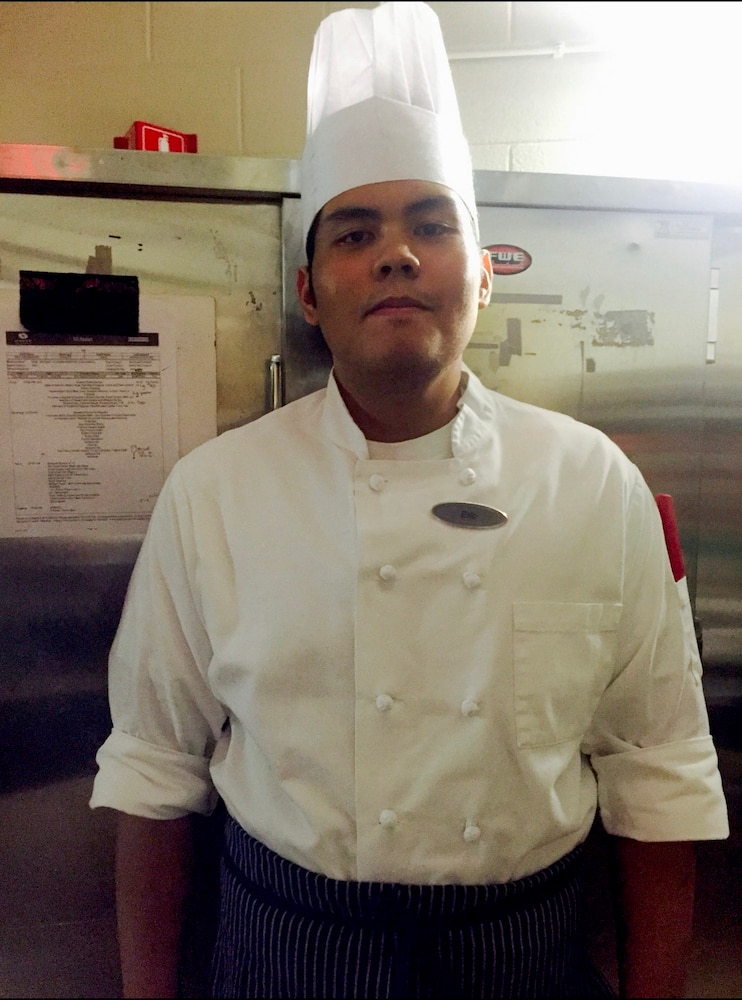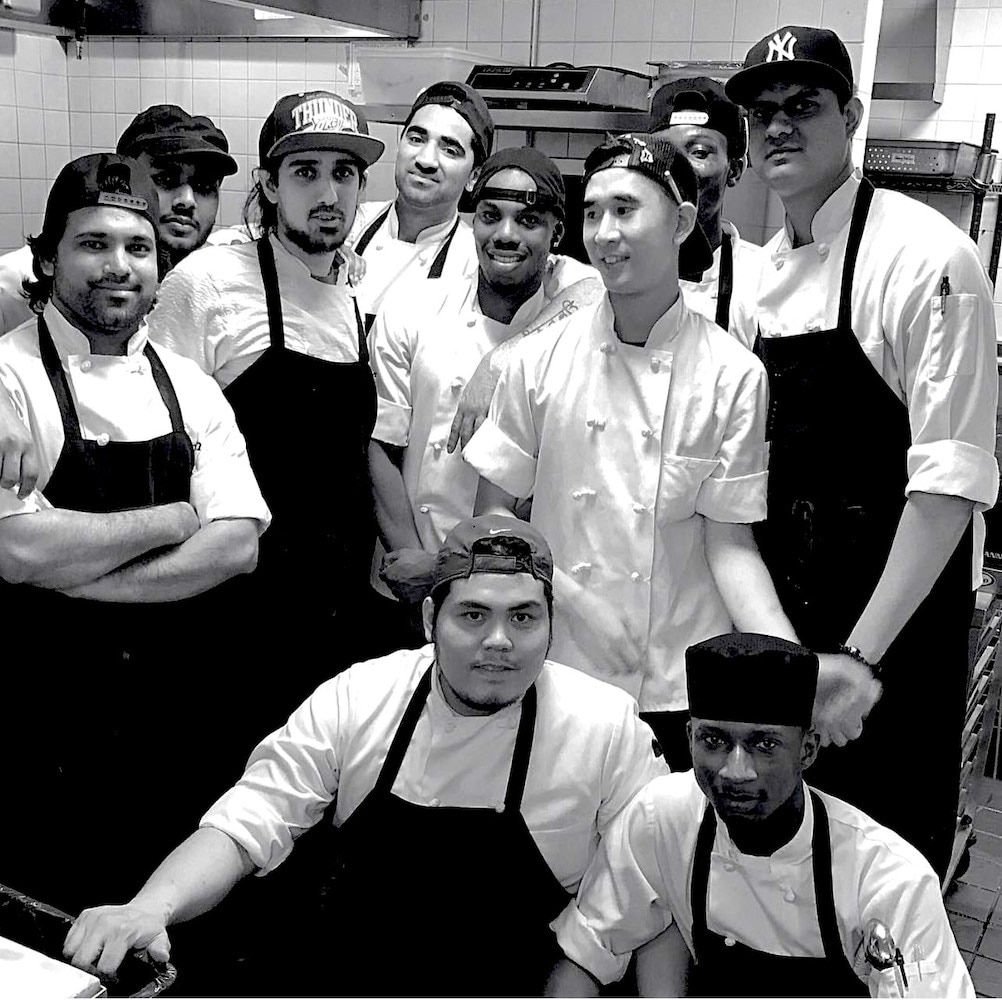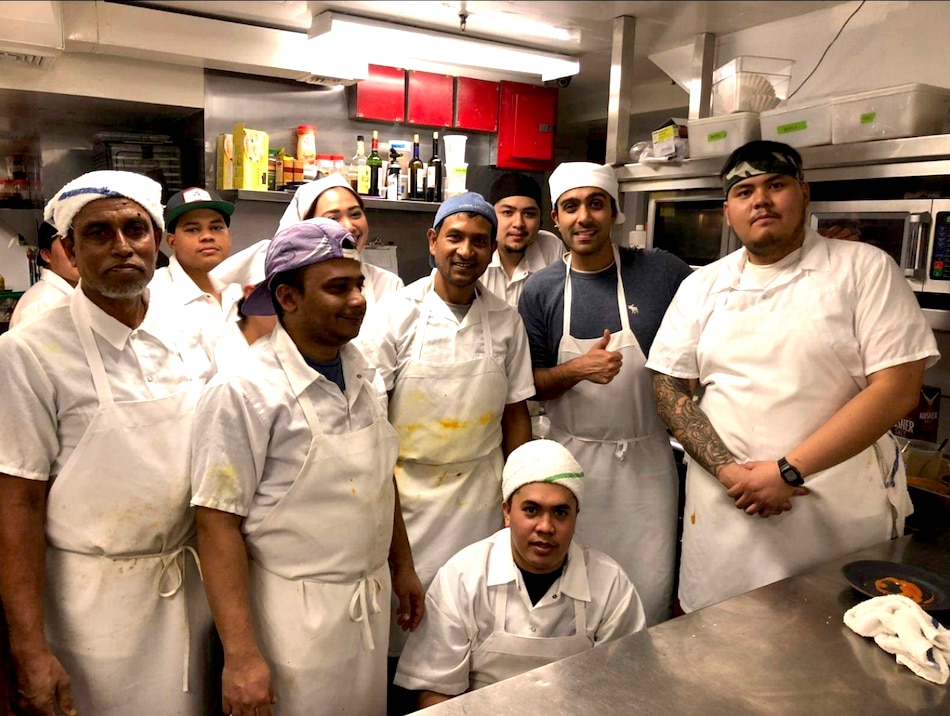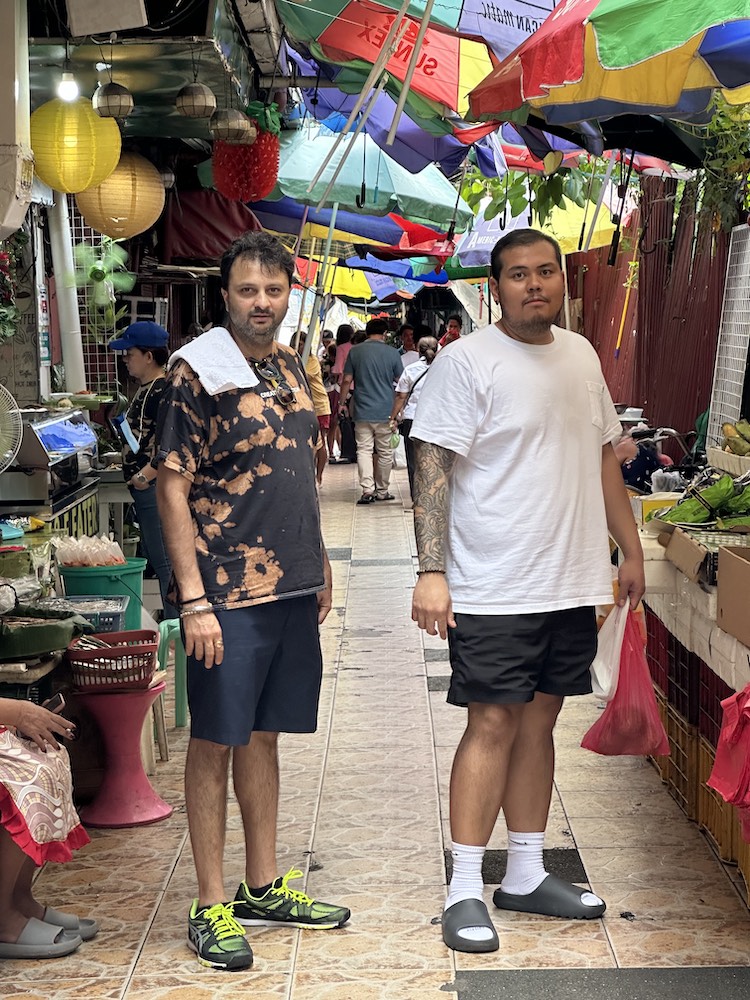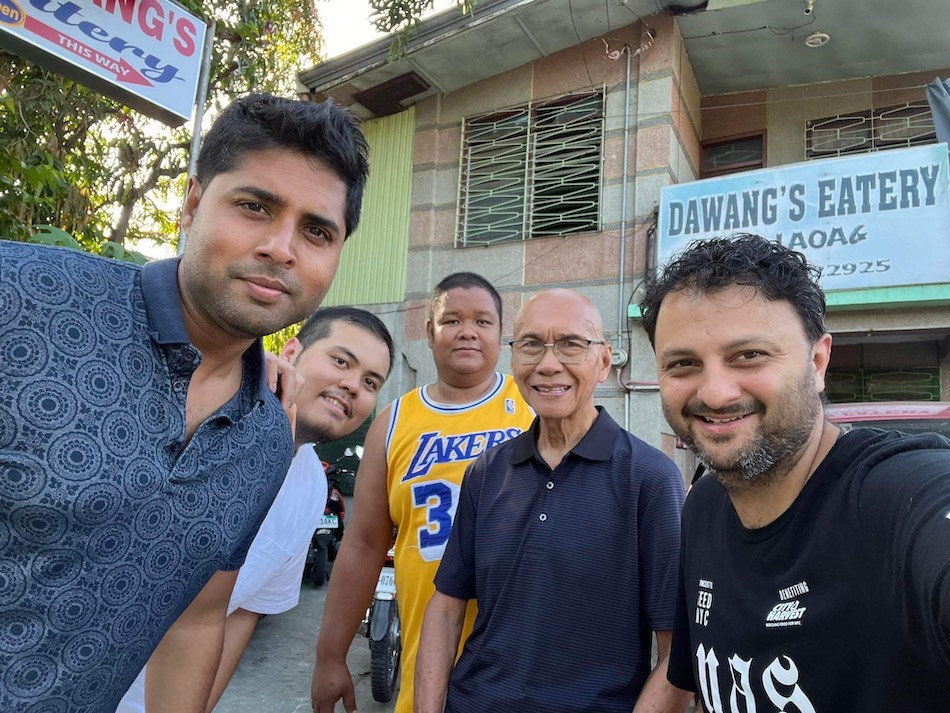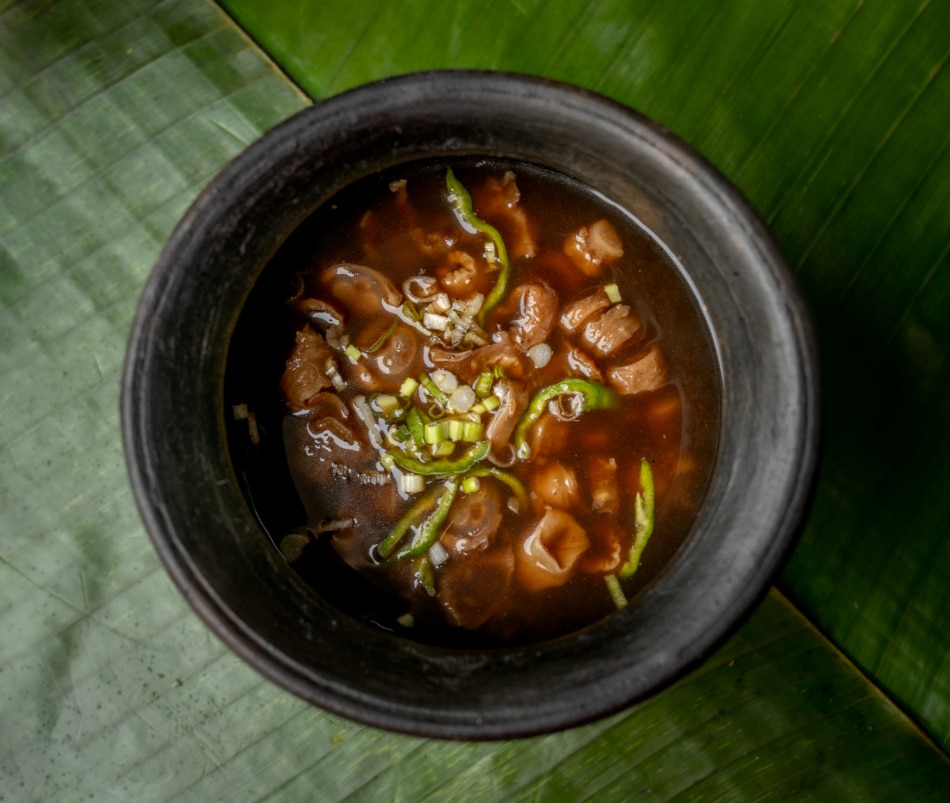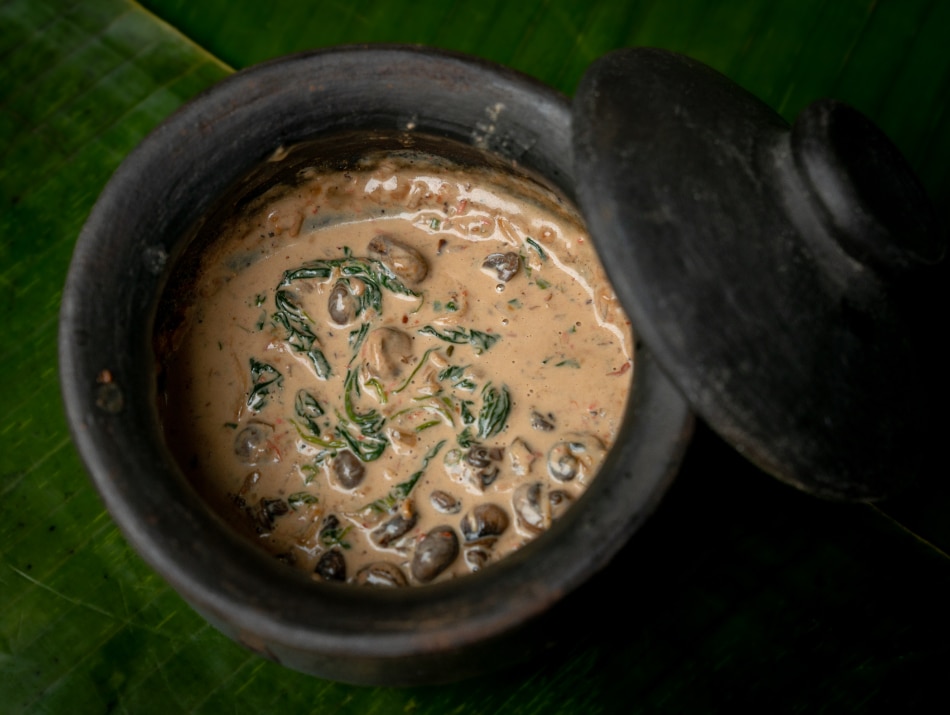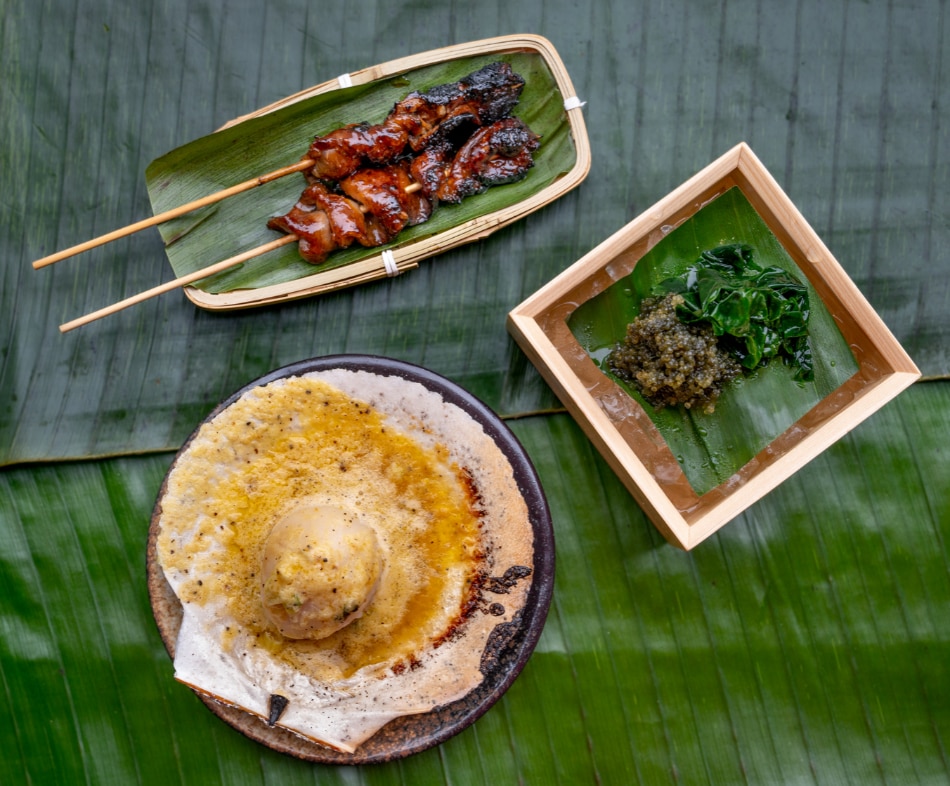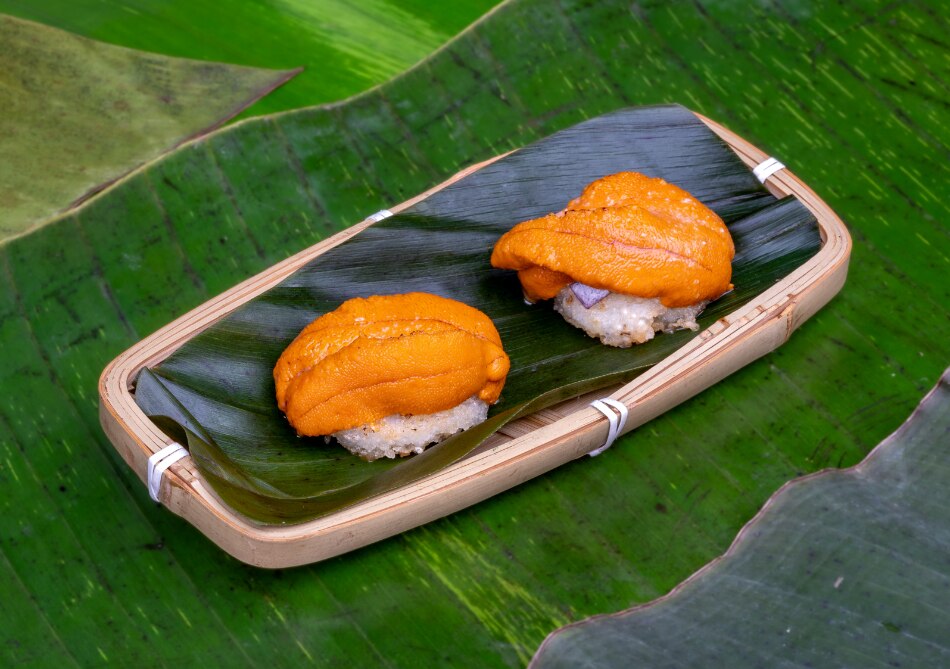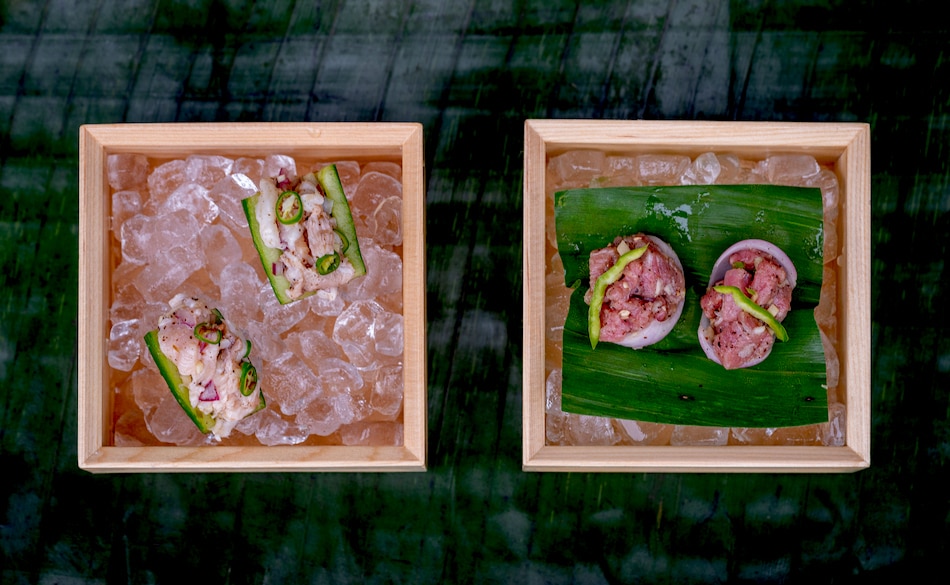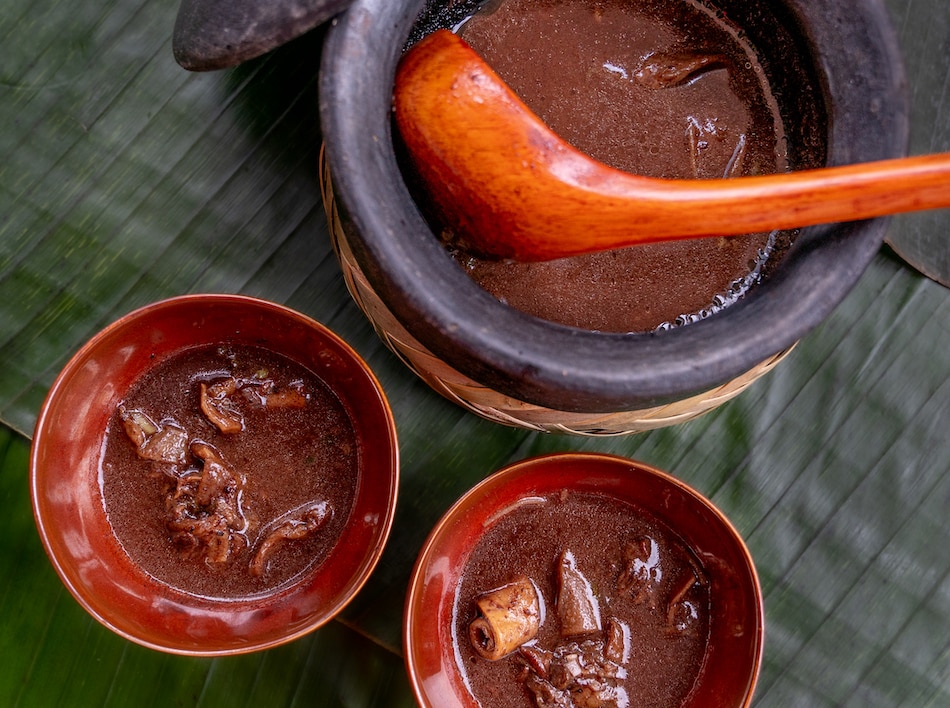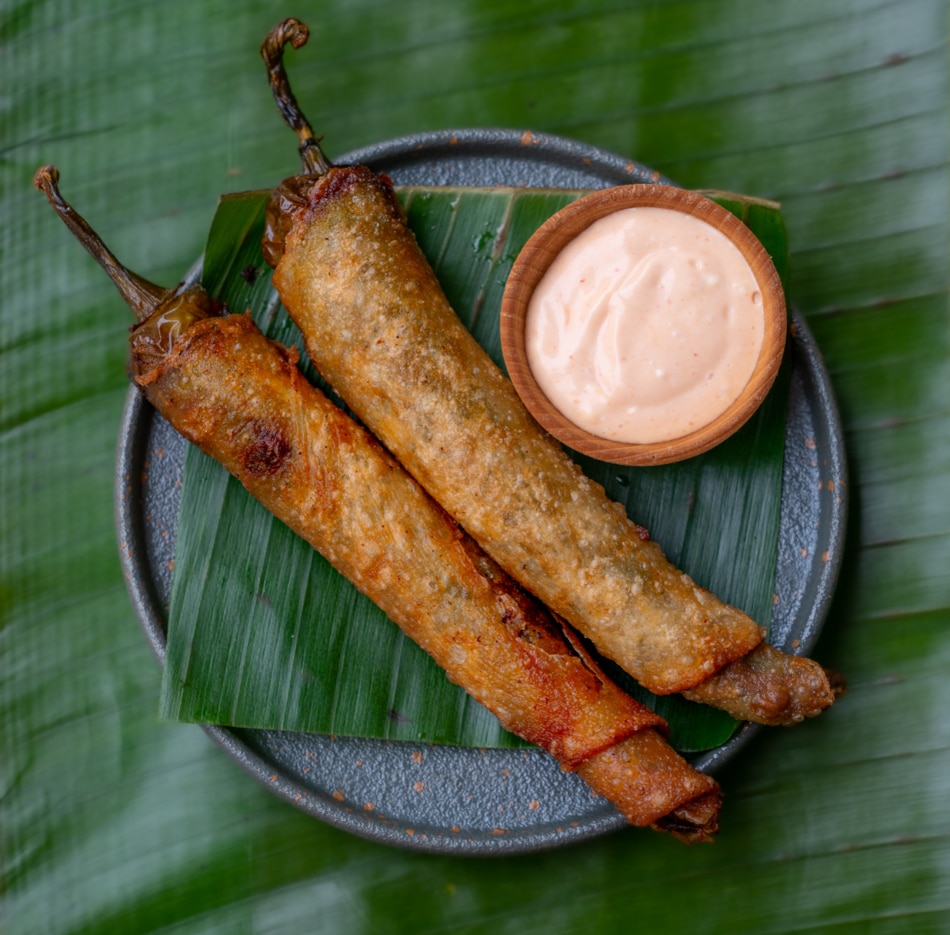Makati-born chef is bringing Soup no. 5, kanto fried chicken, bas-oy to New York via restaurant Naks | ABS-CBN
ADVERTISEMENT

Welcome, Kapamilya! We use cookies to improve your browsing experience. Continuing to use this site means you agree to our use of cookies. Tell me more!
Makati-born chef is bringing Soup no. 5, kanto fried chicken, bas-oy to New York via restaurant Naks
Makati-born chef is bringing Soup no. 5, kanto fried chicken, bas-oy to New York via restaurant Naks
RHIA GRANA
Published Sep 04, 2023 01:51 PM PHT
|
Updated Sep 04, 2023 01:58 PM PHT
At the age of 21, Eric Valdez made the biggest career leap of his life. He was a novice chef getting bored at a popular tapas and wine bar in Makati when he found an ad online. The Hyatt Regency in New Orleans was looking for an intern.
At the age of 21, Eric Valdez made the biggest career leap of his life. He was a novice chef getting bored at a popular tapas and wine bar in Makati when he found an ad online. The Hyatt Regency in New Orleans was looking for an intern.
The Makati-born Valdez earned his bachelor's degree in Hospitality Management at Adamson University. This was followed by a short stint as a junior cook in Dusit Thani. With a goal to become a full-fledged chef, he studied culinary arts for another year at American Hospitality Academy in Makati before embarking on his next steps. Bearing a J1 visa, he flew to New Orleans on his own in 2015 to chase his dreams.
The Makati-born Valdez earned his bachelor's degree in Hospitality Management at Adamson University. This was followed by a short stint as a junior cook in Dusit Thani. With a goal to become a full-fledged chef, he studied culinary arts for another year at American Hospitality Academy in Makati before embarking on his next steps. Bearing a J1 visa, he flew to New Orleans on his own in 2015 to chase his dreams.
After finishing his internship for a good one year and three months at Hyatt Regency in New Orleans, he decided to move to New York in 2016 to further enrich his culinary knowhow. “It’s very different in New York, it’s more competitive and there are a lot of really talented chefs,” he tells ANCX. “It's a melting pot of cultures.” He knew navigating the culinary world there was going to be more challenging but he was up for it.
After finishing his internship for a good one year and three months at Hyatt Regency in New Orleans, he decided to move to New York in 2016 to further enrich his culinary knowhow. “It’s very different in New York, it’s more competitive and there are a lot of really talented chefs,” he tells ANCX. “It's a melting pot of cultures.” He knew navigating the culinary world there was going to be more challenging but he was up for it.
“In 2016, I was jumping around different restaurants because I couldn't find the right restaurant for me,” he shares. He was looking for work experiences that will allow him to learn more and harness his potentials. He worked at Irish pubs, Filipino, American and French restaurants. Until he saw an ad on Craigslist that Michelin-starred Indian restaurant, Junoon, was looking for cooks. He applied, got hired, and had the chance to work closely with then executive chef Chintan Pandya.
“In 2016, I was jumping around different restaurants because I couldn't find the right restaurant for me,” he shares. He was looking for work experiences that will allow him to learn more and harness his potentials. He worked at Irish pubs, Filipino, American and French restaurants. Until he saw an ad on Craigslist that Michelin-starred Indian restaurant, Junoon, was looking for cooks. He applied, got hired, and had the chance to work closely with then executive chef Chintan Pandya.
ADVERTISEMENT
After a year of working at Junoon, Valdez felt there was little room for growth at the restaurant. “As a young cook, you want to explore and try a lot of things,” he recalls. “But in that restaurant, they were not very open to different approaches [in preparing food] because they follow a set standard to maintain the Michelin star.”
After a year of working at Junoon, Valdez felt there was little room for growth at the restaurant. “As a young cook, you want to explore and try a lot of things,” he recalls. “But in that restaurant, they were not very open to different approaches [in preparing food] because they follow a set standard to maintain the Michelin star.”
It turns out Pandya was also feeling the same and was planning to put up his own restaurant concept via Unapologetic Foods, a company he cofounded with business partner Roni Mazumdar. After leaving Junoon, Pandya hired Valdez, then only 25, to become chef de cuisine at Rahi, which served modern Indian cuisine. “Rahi had a modern, playful approach to food. We called it fun dining, not fine dining,” offers Valdez. “Me and chef [Chintan], we always want to do something new. Yung hindi karaniwang ginagawa ng iba, yun ang gusto namin gawin. Ganoon kami mag-isip.”
It turns out Pandya was also feeling the same and was planning to put up his own restaurant concept via Unapologetic Foods, a company he cofounded with business partner Roni Mazumdar. After leaving Junoon, Pandya hired Valdez, then only 25, to become chef de cuisine at Rahi, which served modern Indian cuisine. “Rahi had a modern, playful approach to food. We called it fun dining, not fine dining,” offers Valdez. “Me and chef [Chintan], we always want to do something new. Yung hindi karaniwang ginagawa ng iba, yun ang gusto namin gawin. Ganoon kami mag-isip.”
At Rahi, Valdez got to play around with flavors and use Filipino ingredients like banana ketchup, bagoong, patis, and miso. “Some say it’s not very true to [Indian] cuisine, but it’s what the people were looking for at that time,” he says. “We added Asian elements that were not common and a lot of people found that interesting.”
At Rahi, Valdez got to play around with flavors and use Filipino ingredients like banana ketchup, bagoong, patis, and miso. “Some say it’s not very true to [Indian] cuisine, but it’s what the people were looking for at that time,” he says. “We added Asian elements that were not common and a lot of people found that interesting.”
Before long, the restaurant was getting rave reviews from publications like The New York Times and NY Eater.
Before long, the restaurant was getting rave reviews from publications like The New York Times and NY Eater.
Valdez is grateful to Pandya for imparting his culinary knowledge to him. “Si Chef Chintan kasi sobrang tutok niya sa akin e. Gusto niyang natututo ako palagi,” the Pinoy says of his boss. “Blessing naman na ganoon siya. Marami kasing chef na hindi nagtuturo. Siya, talagang gusto niya akong mag-grow.”
Valdez is grateful to Pandya for imparting his culinary knowledge to him. “Si Chef Chintan kasi sobrang tutok niya sa akin e. Gusto niyang natututo ako palagi,” the Pinoy says of his boss. “Blessing naman na ganoon siya. Marami kasing chef na hindi nagtuturo. Siya, talagang gusto niya akong mag-grow.”
ADVERTISEMENT
In 2021, the company embarked on another milestone by opening Dhamaka, which showcases provincial Indian cuisine. As Rahi evolved to become a new restaurant concept called Semma, featuring Southern Indian cuisine, Valdez was tapped to become Dhamaka’s chef de cuisine. “What we served there are dishes that no one talks about,” he says.
In 2021, the company embarked on another milestone by opening Dhamaka, which showcases provincial Indian cuisine. As Rahi evolved to become a new restaurant concept called Semma, featuring Southern Indian cuisine, Valdez was tapped to become Dhamaka’s chef de cuisine. “What we served there are dishes that no one talks about,” he says.
For bringing the spotlight on Indian cuisine via Dhamaka, Pandya won the James Beard award for best chef in New York state in 2022.
For bringing the spotlight on Indian cuisine via Dhamaka, Pandya won the James Beard award for best chef in New York state in 2022.
Since joining Unapologetic Foods in 2017, Valdez has been open to his bosses about his goals and aspirations. “One day, I’d put up a Filipino restaurant,” he remembers telling them. At that time though, he didn’t know yet the concept for his dream dining spot. Dhamaka opened his eyes to a realization: “There is an opportunity in regional cuisine.”
Since joining Unapologetic Foods in 2017, Valdez has been open to his bosses about his goals and aspirations. “One day, I’d put up a Filipino restaurant,” he remembers telling them. At that time though, he didn’t know yet the concept for his dream dining spot. Dhamaka opened his eyes to a realization: “There is an opportunity in regional cuisine.”
“If you grew up in the Philippines, you’d know that Filipino food here in New York is very different, very commercialized,” Valdez shares. “It’s mostly pancit, lumpia, adobo. Ganon lang ang tingin nila sa Filipino food. What I’d like to do is break that barrier. I want to show people that there are Filipino dishes that are delicious and more interesting than adobo and lumpia.”
“If you grew up in the Philippines, you’d know that Filipino food here in New York is very different, very commercialized,” Valdez shares. “It’s mostly pancit, lumpia, adobo. Ganon lang ang tingin nila sa Filipino food. What I’d like to do is break that barrier. I want to show people that there are Filipino dishes that are delicious and more interesting than adobo and lumpia.”
Valdez grew up in Makati but his mother hails from Ilocos and his father is from Tarlac. “During summer break, nauwi kami ng probinsya. Nag-eenjoy akong manood ng mga nagluluto sa mga fiesta,” he says, looking back.
Valdez grew up in Makati but his mother hails from Ilocos and his father is from Tarlac. “During summer break, nauwi kami ng probinsya. Nag-eenjoy akong manood ng mga nagluluto sa mga fiesta,” he says, looking back.
ADVERTISEMENT
Their neighborhood in Tejeros, Makati is also a mix of people from different provinces, so he got exposed to different kinds of regional cuisines as a young boy. “May kapitbahay akong taga Iloilo, Marinduque, Cavite, Pampanga so iba’t ibang pagkain ang natitikman ko when I was young,” he says. “Naranasan ko na yung mga magkakapitbahay nagbibigayan ng sobrang ulam.”
Their neighborhood in Tejeros, Makati is also a mix of people from different provinces, so he got exposed to different kinds of regional cuisines as a young boy. “May kapitbahay akong taga Iloilo, Marinduque, Cavite, Pampanga so iba’t ibang pagkain ang natitikman ko when I was young,” he says. “Naranasan ko na yung mga magkakapitbahay nagbibigayan ng sobrang ulam.”
The foods he grew up with as well as his experiences traveling around the Philippines became his inspiration for the new Filipino restaurant the group be launching. A month ago, Valdez, Pandya and Mazumdar flew to the Philippines to do some R&D. For eight days, they explored places in Luzon, Visayas, Mindanao. “Nilibot ko sila sa streets of Manila. Then we went Pampanga, Ilocos, Cebu, Davao. I wanted to show them the cultural differences in the different regions. I also wanted them to be exposed to the food. Kasi kung dito lang kami mag R&D, pare-parehas lang ang makikita naming pagkain. Hindi nila maiintindihan ang vision ko.”
The foods he grew up with as well as his experiences traveling around the Philippines became his inspiration for the new Filipino restaurant the group be launching. A month ago, Valdez, Pandya and Mazumdar flew to the Philippines to do some R&D. For eight days, they explored places in Luzon, Visayas, Mindanao. “Nilibot ko sila sa streets of Manila. Then we went Pampanga, Ilocos, Cebu, Davao. I wanted to show them the cultural differences in the different regions. I also wanted them to be exposed to the food. Kasi kung dito lang kami mag R&D, pare-parehas lang ang makikita naming pagkain. Hindi nila maiintindihan ang vision ko.”
“It was hours of just eating, eating, eating,” Pandya told Grubstreet about their trip. “It was obscene,” Mazumdar added. When the trip was over, they told Valdez, “You are right, food here [in the Philippines] is very different. We need to bring this over to New York.”
“It was hours of just eating, eating, eating,” Pandya told Grubstreet about their trip. “It was obscene,” Mazumdar added. When the trip was over, they told Valdez, “You are right, food here [in the Philippines] is very different. We need to bring this over to New York.”
They picked a colloquial Pinoy expression as the name of their new project—Naks—which conveys surprise and admiration. For Valdez, Naks is also a “unique, vibrant and fun word” that aptly describes Filipino cuisine. The guys at Unapologetic Foods tend to pick one word names that have a powerful meaning like Dhamaka, which means explosion, and Semma, which means excellent.
They picked a colloquial Pinoy expression as the name of their new project—Naks—which conveys surprise and admiration. For Valdez, Naks is also a “unique, vibrant and fun word” that aptly describes Filipino cuisine. The guys at Unapologetic Foods tend to pick one word names that have a powerful meaning like Dhamaka, which means explosion, and Semma, which means excellent.
Naks is opening by the third week of September. To give us an idea, the team sent us photographs of the foods they’ll be offering at Naks and we were instantly blown away by the lineup. There’s Dinuguan na Kambing, Ginataang Kohol, Igado, Imbaliktad, Kinilaw na Bat, Morcon, Pancit Batil, Prating Itik, Lapu-Lapu de la Reyna, Halamang Dagat, Pinakbet Ilokano, Bas-oy, Soup No. 5, Swaki—dishes not commonly served in many Filipino restaurants in Metro Manila.
Naks is opening by the third week of September. To give us an idea, the team sent us photographs of the foods they’ll be offering at Naks and we were instantly blown away by the lineup. There’s Dinuguan na Kambing, Ginataang Kohol, Igado, Imbaliktad, Kinilaw na Bat, Morcon, Pancit Batil, Prating Itik, Lapu-Lapu de la Reyna, Halamang Dagat, Pinakbet Ilokano, Bas-oy, Soup No. 5, Swaki—dishes not commonly served in many Filipino restaurants in Metro Manila.
ADVERTISEMENT
Valdez did not miss out on the street foods, too. He has his own version of KFC (Kanto Fried Chicken), Inihaw na Balat, and Singkamas at Mangga with Bagoong. If you’re looking for lumpiang shanghai, go elsewhere because at Naks, what they’re serving are lumpiang togue and dinamita.
Valdez did not miss out on the street foods, too. He has his own version of KFC (Kanto Fried Chicken), Inihaw na Balat, and Singkamas at Mangga with Bagoong. If you’re looking for lumpiang shanghai, go elsewhere because at Naks, what they’re serving are lumpiang togue and dinamita.
“It's a crazy concept. But I think it’s going to be worth it,” says Valdez, sounding excited, “because a lot of people will open their eyes to the real Filipino cuisine.”
“It's a crazy concept. But I think it’s going to be worth it,” says Valdez, sounding excited, “because a lot of people will open their eyes to the real Filipino cuisine.”
The young chef—he’s turning 31 this September—is committed to offering Filipino food in its truest form. “If you taste the lumpia over here in New York, it’s very commercialized. They use egg roll wrapper. Back home, ang lumpia wrapper natin ay yung manipis, so that’s what I’ll do. Everything's going to be homemade. If we don't make it, we won't serve it.”
The young chef—he’s turning 31 this September—is committed to offering Filipino food in its truest form. “If you taste the lumpia over here in New York, it’s very commercialized. They use egg roll wrapper. Back home, ang lumpia wrapper natin ay yung manipis, so that’s what I’ll do. Everything's going to be homemade. If we don't make it, we won't serve it.”
Instead of canned coconut milk, he’ll use kakang gata. “I know it’s going to be very labor intensive, but I think it's going to be worth it because the taste will be different,” he says. His dinakdakan will have pork brain in it, not mayonnaise.
Instead of canned coconut milk, he’ll use kakang gata. “I know it’s going to be very labor intensive, but I think it's going to be worth it because the taste will be different,” he says. His dinakdakan will have pork brain in it, not mayonnaise.
There will be two rooms in the restaurant. The first room, which can seat about 60, is for a la carte diners. The other room, which can seat 20, is only for kamayan. They will accept walk-ins for those availing the a la carte menu, but they will require advanced booking for kamayan. “The kamayan is a different experience. We’re offering a tasting menu but we’ll use our hands. We’ll have 15 to 16 courses but served family style,” he says.
There will be two rooms in the restaurant. The first room, which can seat about 60, is for a la carte diners. The other room, which can seat 20, is only for kamayan. They will accept walk-ins for those availing the a la carte menu, but they will require advanced booking for kamayan. “The kamayan is a different experience. We’re offering a tasting menu but we’ll use our hands. We’ll have 15 to 16 courses but served family style,” he says.
ADVERTISEMENT
We ask if he thinks the people in the Big Apple are ready for this kind of Filipino food. “I hope so,” he answers seriously. “I think if you push for something and you work hard for it, you can achieve anything. We just need to believe in it. Since day one, I just believed in myself. I just believed in what I'm doing.” The serious look on his face gives way to a smile.
We ask if he thinks the people in the Big Apple are ready for this kind of Filipino food. “I hope so,” he answers seriously. “I think if you push for something and you work hard for it, you can achieve anything. We just need to believe in it. Since day one, I just believed in myself. I just believed in what I'm doing.” The serious look on his face gives way to a smile.
“We should not be afraid of our own cuisine and culture,” he says. “We always apologize that our food is very smelly, very garlicky, very brown. Instead of downgrading our own culture, we should embrace and appreciate its own beauty.”
“We should not be afraid of our own cuisine and culture,” he says. “We always apologize that our food is very smelly, very garlicky, very brown. Instead of downgrading our own culture, we should embrace and appreciate its own beauty.”
Photos courtesy of Unapologetic Foods and Chef Eric Valdez
Read More:
anc
ancx
ancx.ph
abs-cbn
abs-cbn news
food and drink
restaurant
anc promo
ancx featured
special feature
ADVERTISEMENT
ADVERTISEMENT



